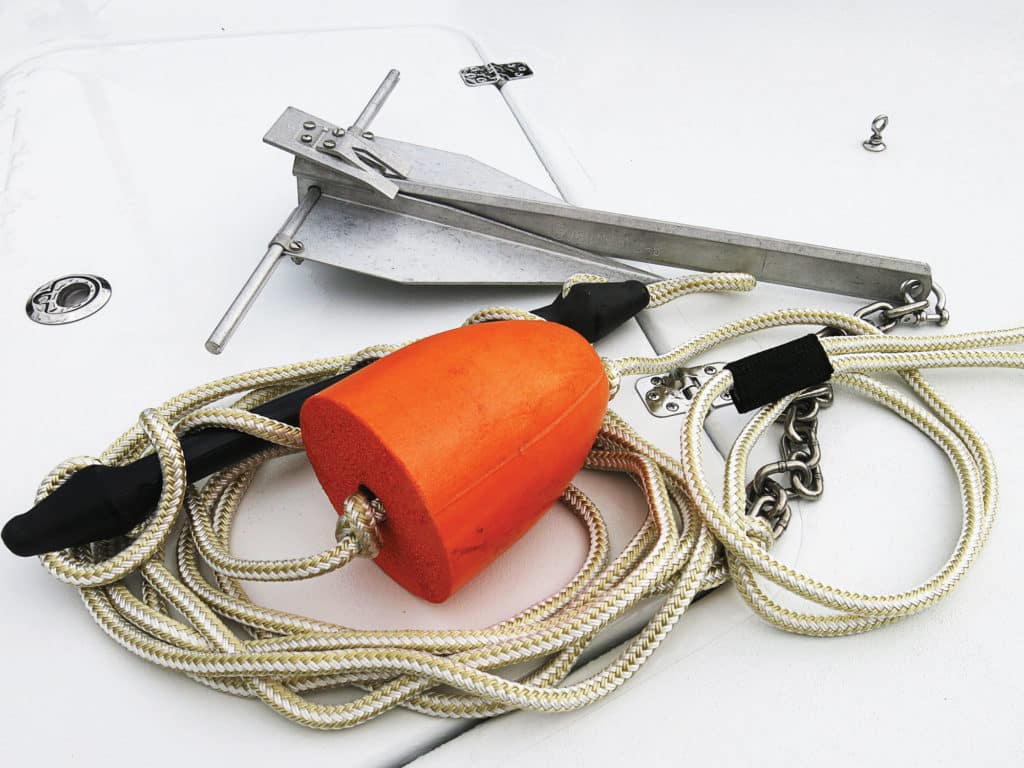
Hovering right over a reef or wreck typically means more fish in the box. Inshore, staying put in a creek mouth or channel, or within casting range of a trough or pothole also improves an angler’s chances for success. A quick-release anchoring system allows you to hold fast and, when needed, free the boat instantly to follow a hooked fish or intercept incoming targets.
Options Abound
Traditional anchors do the job, but they’re cumbersome, noisy, and can damage sensitive coral and sea grass. In addition, the scope of the rode connecting your boat to the anchor leaves room for potentially significant position changes caused by wind and current. Modern technology now makes other options available, and we weighed their benefits against those of time-proven anchoring methods.
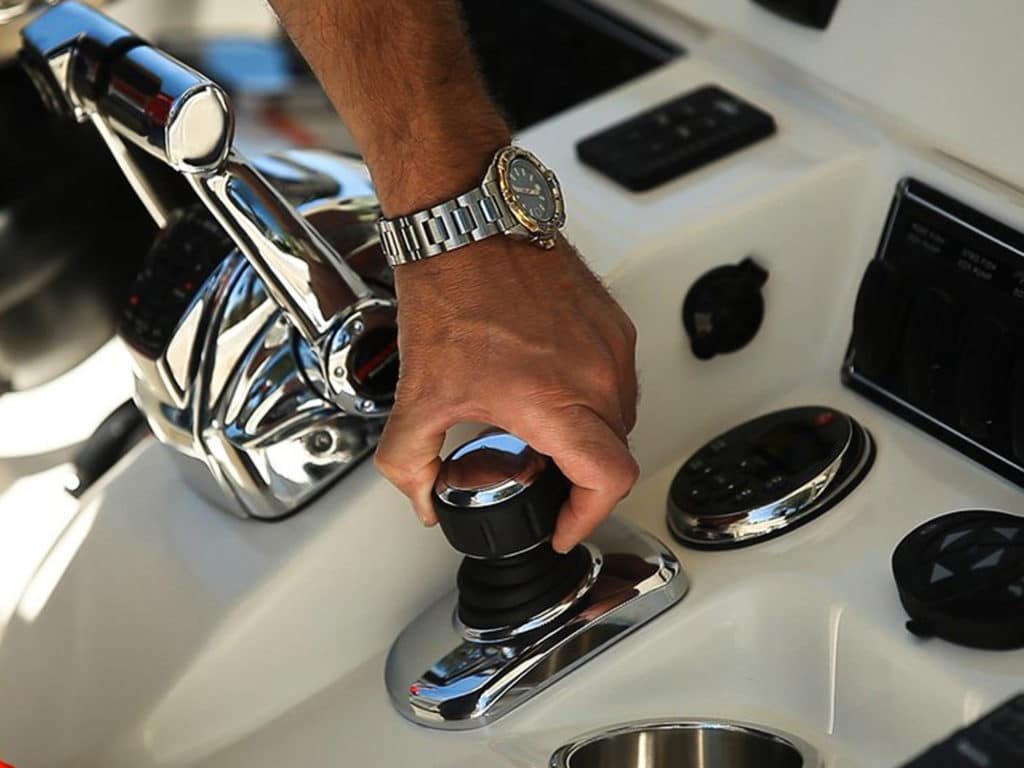
VIRTUAL ANCHORS
Mercury Marine’s Joystick Piloting, which utilizes a computer to steer and throttle multiple outboards individually and maneuver the boat at low speeds with input from a joystick-style control, incorporates a Skyhook application that uses GPS to hold the boat at a selected position, and even keeps it pointing in the direction desired. It is offered as an option on new boats powered by two or more Mercury Verados (250 hp and up), with a setup for twins starting at about $15,000.
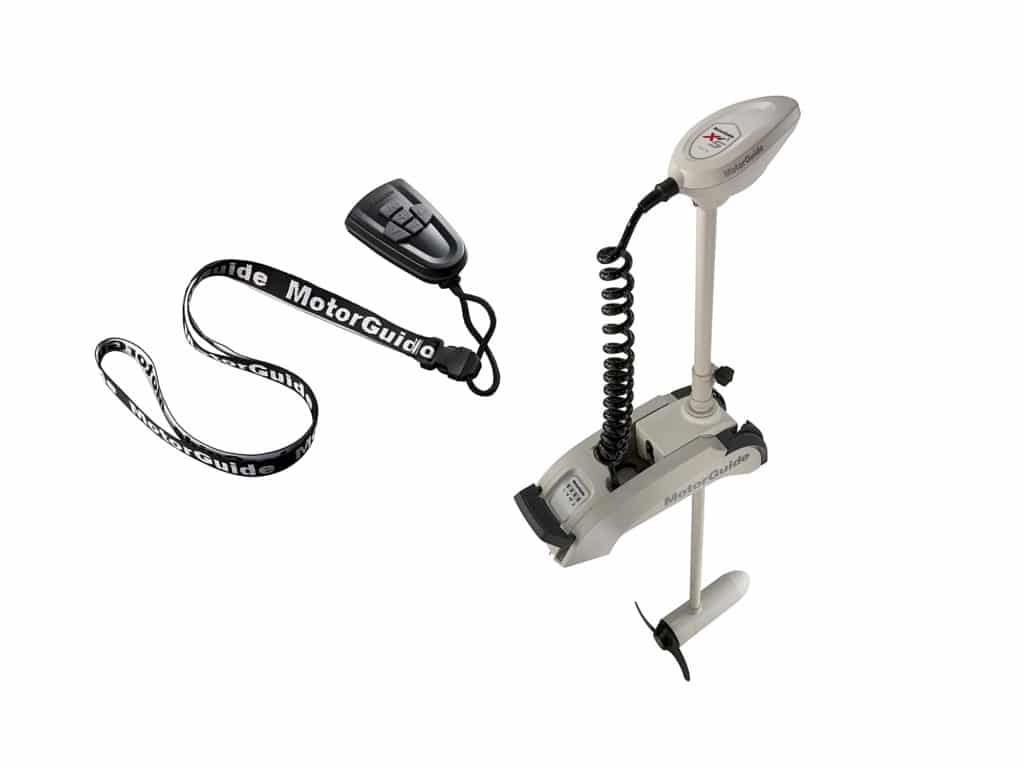
TROLLING MOTOR GPS TECHNOLOGY
New GPS technology now incorporated in top trolling-motor models also enables you to hold on a specific spot without anchoring or staking out. MotorGuide’s Pinpoint GPS control, available as a factory-installed feature on Xi5 models or sold separately as an upgrade, keeps the boat on a fixed GPS coordinate by simply switching on the Anchor Mode. Minn Kota’s i-Pilot — available on Riptide models — offers Spot-Lock, a similar feature that maintains the boat over a selected spot, taking you back automatically every time you drift 5 feet from it. Not to be outdone, Rhodan, another contender in the high-end trolling motor market, offers the patented HD GPS Anchor+ feature on its GPS-guided trolling motors to keep the bow of the boat within a few feet of a particular spot. Like MotorGuide and Minn Kota, Rhodan’s anchor feature is activated with the touch of a button on the wireless remote. Models for saltwater use from all three brands with the respective GPS anchoring features start at more than $1,000.
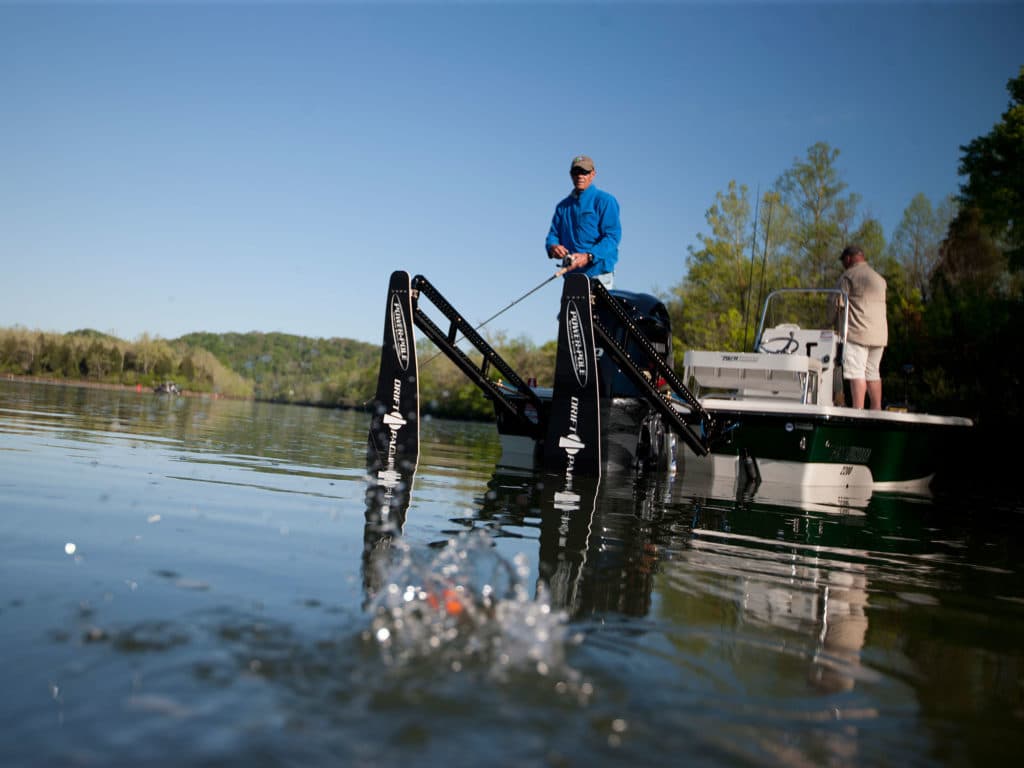
PUSH-BUTTON STAKE OUT
More quiet than combustion or electric motors that constantly run to keep the boat in position, Power-Pole and Minn Kota offer widely popular shallow-water anchoring systems that mount permanently on the transom and deploy a fiberglass spike to stake out the boat. Both form a vertical housing that is mounted on the transom of the boat. Most Power-Pole models use a hydraulic pump to deploy a retractable arm to which the stake-out spike is attached. The hydraulic pump is compact but still requires mounting room in the bilge or an aft compartment. The one exception is the Micro Anchor (for very light poling skiffs and jon boats), which counts on its self-contained electro-mechanical machinery to push a removable spike up and down.
Like Power-Pole’s Micro Anchor, Minn Kota’s Talon anchoring systems are self-contained electro-mechanical units that extend stake-out spikes straight down and don’t require mounting space for pumps. The housing, however, remains upright (unlike Power-Pole’s hydraulic arm, which drops to set the spike in the bottom), so anglers in the rear of the boat must mind their backcasts. Power-Poles and Talons are conveniently activated via wireless remotes or dash-mount switches. The working depth of either (Power-Pole offers 10-foot models, and Talon offers 12-foot models) and its hold on the bottom depend on wave action and bottom composition. The noise of the motors is comparable, and both brands offer the ability to compensate for the wave action and to slow the deployment for reduced noise. Boats tend to swing or pivot with a single spike system, so many guides and tournament anglers install twin Power-Poles or Talons to prevent it. But with prices ranging from $1,500 to $2,000 for top models, doubling up isn’t a viable solution for everyone.
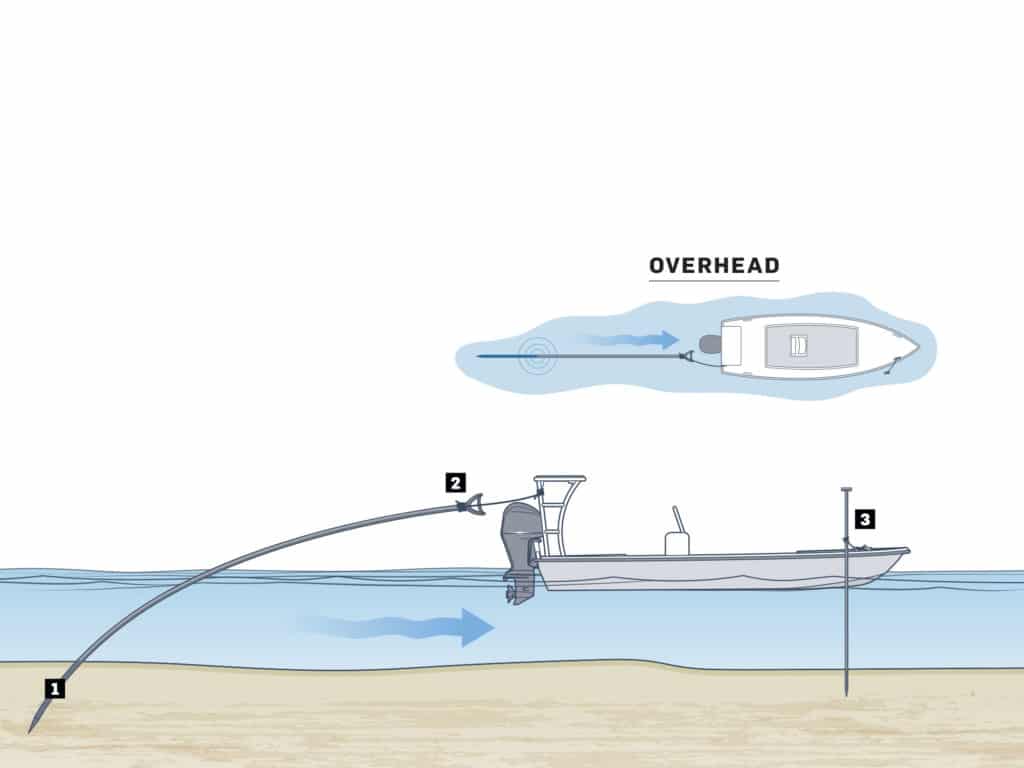
MANUAL STAKE OUT
Anchor spikes and stake-out poles are manual and considerably more economical alternatives. Simple rods are made from galvanized or stainless steel, solid fiberglass or aluminum, and most of these pins cost less than $100, range in length from 4 to 12 feet, and can be easily stowed when not in use. Lacking any noisy propulsion or deployment mechanism, anchor pins and stake-out poles are quiet. The metal stakes have heft to easily penetrate soft bottom, while the flex of fiberglass types provide greater holding power in current. They attach to the boat with a welded or bolt-on bracket, or with a simple lanyard that ties around a cleat or poling-platform leg. Common drawbacks are they all require some muscle to deploy and retrieve, and, as when using a Power-Pole or Talon, a boat is likely to swing or pivot when a single spike is used.
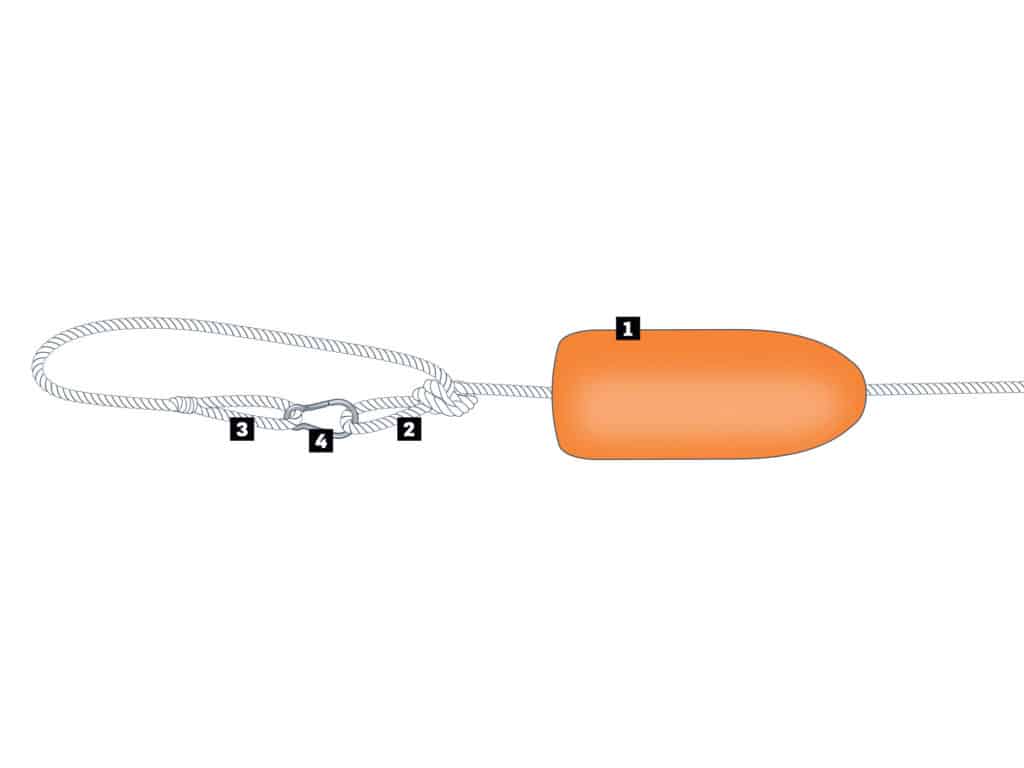
SIMPLE RELEASE ANCHOR SYSTEM
Slide a buoy onto your anchor rode.
Tie a loop knot to lock it in, leaving a 6- to 8-foot tag end.
AdvertisementAttach a clip to a second loop on the end.
Run the clip through the boat bow eye and snap it to the loop.
Release Anchors
One thing all the aforementioned systems have in common is they all release the boat’s hold instantly. With that in mind, I present another inexpensive option but with a twist: Use an anchor to hold the boat in place but incorporate a release system that allows you to cast off the anchor line quickly to chase after a hooked fish while the anchor remains in place so you can return to that exact spot after the battle. The release anchor system is a staple of tarpon, permit and shark anglers, and a useful tool for anyone who targets big fish with light tackle, whether inshore, nearshore or offshore.
Construction is simple. Choose a fluke-style (aka Danforth) anchor that matches your boat’s size. For the flats, a 6- to 8-pounder usually works well. Depending on the depth you normally fish, get 20, 30 or more feet of 3/8-inch nylon dock line with a loop spliced into one end. You’ll also need a brightly colored PVC buoy or a crab-trap float. Slide the float onto the line past the splice and tie a loop knot above the float to keep it in place on the rode about 6 feet from the end. Snap a spring clip on the loop above the float. To anchor, run the loop end through the bow eye and clip it to the loop above the float. When you need to quickly follow a fish, unsnap the clip, pull the rode through the bow eye, and you’re free to move off.
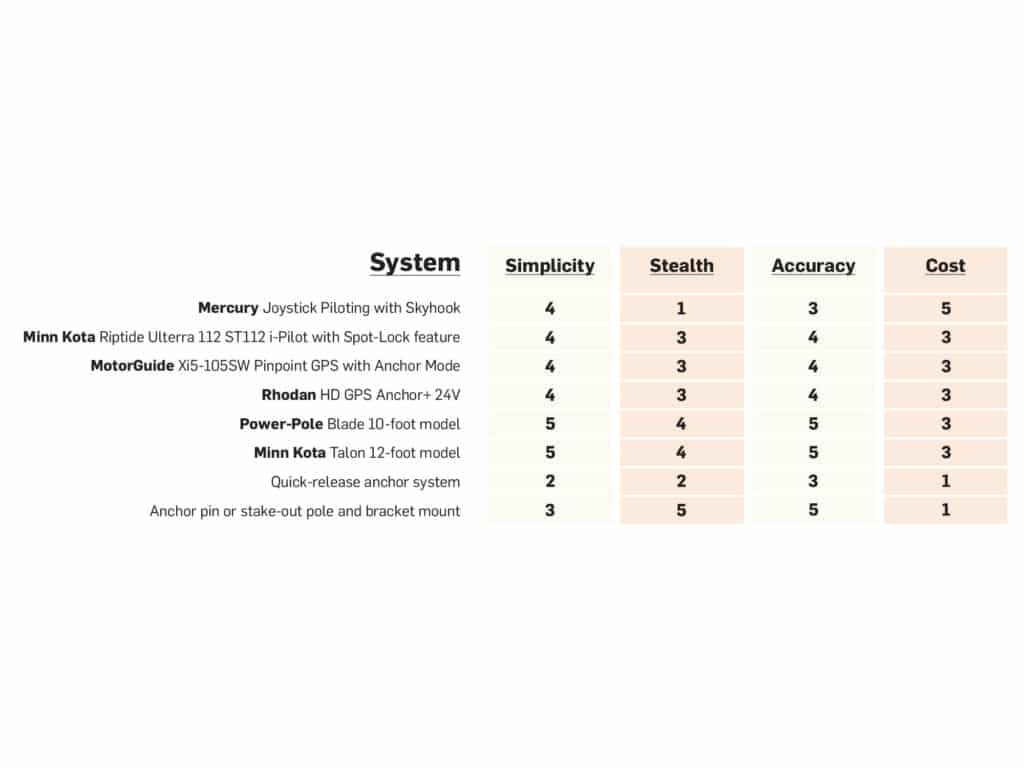
Play It Safe, Maintain a Backup
Even in shallow water, it’s prudent to have redundant ground tackle in case of a breakdown. If you rely primarily on a permanent shallow-water anchor or a manual stake-out pin, a backup anchor and rode will keep the boat from drifting with wind and tide until help arrives. A claw- or plow-style anchor holds well in various types of bottom and takes up little room aboard. A canvas or vinyl sea anchor is another handy safety item. The cone-shaped material can be rolled up for minimal storage space, and tying one off the bow will at least keep your vessel facing into the waves until a towboat arrives. A 5-gallon bucket also works in a pinch.









